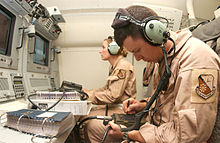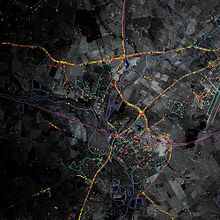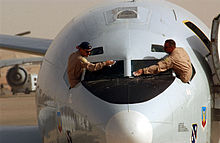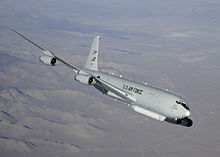- Northrop Grumman E-8 Joint STARS
-
E-8 Joint STARS USAF E-8C Joint STARS Role Airborne battle management Manufacturer Northrop Grumman Introduction 1991 Primary users United States Air Force
Air National GuardNumber built 17 Unit cost US$244.4 million in 1998 Developed from Boeing 707 The Northrop Grumman E-8 Joint Surveillance Target Attack Radar System (Joint STARS) is a battle management and command and control aircraft of the United States Air Force. It tracks ground vehicles and some aircraft, collects imagery, and relays tactical pictures to ground and air theater commanders.
Contents
Development
Joint STARS evolved from separate United States Army and Air Force programs to develop, detect, locate and attack enemy armor at ranges beyond the forward area of troops. In 1982, the programs were merged and the U.S. Air Force became the lead agent. The concept and sensor technology for the E-8 was developed and tested on the Tacit Blue experimental aircraft. The prime contract was awarded to Grumman Aerospace Corporation in September 1985 for two E-8A development systems.
Upgrades
The USAF has selected Pratt & Whitney to replace the engines of its 19 Joint STARS aircraft. Pratt & Whitney, in a joint venture with Seven Q Seven (SQS), will produce and deliver JT8D-219 engines. Their greater efficiency will allow the Joint STARS to spend more time on station, take off from a wider range of runways, climb faster, fly higher all with a much reduced cost per flying hour. Joint STARS is to be used until 2025. As of 24 October 2008, all four Pratt & Whitney JT8D-219 engines have been removed from the B707-330C testbed, N707HE, for installation on the Joint STARS test aircraft for evaluation.
Design
The E-8C is an aircraft modified from the Boeing 707-300 series commercial airliner. The E-8 carries specialized radar, communications, operations and control subsystems. The most prominent external feature is the 40 ft (12 m) canoe-shaped radome under the forward fuselage that houses the 24 ft (7.3 m) side-looking APY-7 phased array antenna.
The E-8C can respond quickly and effectively to support worldwide military contingency operations. It is a jam-resistant system capable of operating while experiencing heavy electronic countermeasures. The E-8C can fly a mission profile for 9 hours without refueling. Its range and on-station time can be substantially increased through in-flight refueling.
Radar and systems
The AN/APY-7 radar can operate in wide area surveillance, ground moving target indicator (GMTI), fixed target indicator (FTI) target classification, and synthetic aperture radar (SAR) modes.
To pick up moving targets, the radar looks at the Doppler frequency shift of the returned signal. It can look from a long range, which the military refers to as a high standoff capability. The antenna can be tilted to either side of the aircraft for a 120-degree field of view covering nearly 50,000 km² (19,305 mile²) and can simultaneously track 600 targets at more than 250 km (152 miles). The GMTI modes cannot pick up objects that are too small, insufficiently dense, or stationary. Data processing allows the APY-7 to differentiate between armored vehicles (tracked tanks) and trucks, allowing targeting personnel to better select the appropriate ordnance for various targets.
The system's SAR modes can produce images of stationary objects. Objects with many angles (for example, the interior of a pick-up bed) will give a much better radar signature, or specular return. In addition to being able to detect, locate and track large numbers of ground vehicles, the radar has a limited capability to detect helicopters, rotating antennas and low, slow-moving fixed-wing aircraft.
The radar and computer subsystems on the E-8C can gather and display broad and detailed battlefield information. Data is collected as events occur. This includes position and tracking information on enemy and friendly ground forces. The information is relayed in near-real time to the US Army's common ground stations via the secure jam-resistant surveillance and control data link (SCDL) and to other ground C4I nodes beyond line-of-sight via ultra high frequency satellite communications.
Other major E-8C prime mission equipment are the communications/datalink (COMM/DLX) and operations and control (O&C)subsystems. Eighteen operator workstations display computer-processed data in graphic and tabular format on video screens. Operators and technicians perform battle management, surveillance, weapons, intelligence, communications and maintenance functions.
Northrop Grumman has tested the installation of a MS-177 camera on an E-8C to provide real time visual target confirmation.[1]
Battle management
In missions from peacekeeping operations to major theater war, the E-8C can provide targeting data and intelligence for attack aviation, naval surface fire, field artillery and friendly maneuver forces. The information helps air and land commanders to control the battlespace.[2]
The E-8's ground-moving radar can tell approximate number of vehicles, location, speed, and direction of travel. It cannot identify exactly what type of vehicle a target is, tell what equipment it has, or discern whether it is friendly, hostile, or a bystander, so commanders often crosscheck the JSTARS data against other sources. In the Army, JSTARS data is analyzed in and disseminated from a Ground Station Module (GSM).
Operational history
Pilots from the Georgia Air National Guard cleaning the windshields of their E-8 before a mission in Iraq
The two E-8A development aircraft were deployed in 1991 to participate in Operation Desert Storm under the direction of Albert J. Verderosa, even though they were still in development. The joint program accurately tracked mobile Iraqi forces, including tanks and Scud missiles. Crews flew developmental aircraft on 49 combat sorties, accumulating more than 500 combat hours and a 100% mission effectiveness rate.
These Joint STARS developmental aircraft also participated in Operation Joint Endeavor, a NATO peacekeeping mission, in December 1995. While flying in friendly air space, the test-bed E-8A and pre-production E-8C aircraft monitored ground movements to confirm compliance with the Dayton Peace Accords agreements.[citation needed] Crews flew 95 consecutive operational sorties and more than 1,000 flight hours with a 98% mission effectiveness rate.
The 93d Air Control Wing, which activated 29 January 1996, accepted its first aircraft, 11 June 1996, and deployed in support of Operation Joint Endeavor in October. The provisional 93d Air Expeditionary Group monitored treaty compliance while NATO rotated troops through Bosnia and Herzegovina. The first production E-8C and a pre-production E-8C flew 36 operational sorties and more than 470 flight hours with a 100 % effectiveness rate. The wing declared initial operational capability 18 December 1997 after receiving the second production aircraft. Operation Allied Force saw Joint STARS in action again from February to June 1999 accumulating more than 1,000 flight hours and a 94.5 % mission-effectiveness rate in support of the U.S. lead Kosovo War.
On 1 October 2002, the 93d Air Control Wing (93 ACW) was "blended" with the 116th Bomb Wing in a ceremony at Robins Air Force Base, Georgia. The 116 BW was an Air National Guard wing equipped with the B-1B Lancer bomber at Robins AFB. As a result of a USAF reorganization of the B-1B force, all B-1Bs were assigned to active duty wings, resulting in the 116 BW lacking a current mission. Extensive efforts by the Georgia's governor and congressional delegation led to the resulting "blending", with the newly created wing designated as the 116th Air Control Wing (116 ACW). The 93 ACW was deactivated the same day. The 116 ACW constituted the first fully blended wing of active duty and Air National Guard airmen.
The 116 ACW has been heavily involved in both Operation Enduring Freedom and Operation Iraqi Freedom, earning high marks for operational effectiveness and recently completing 10,000 combat hours. The wing took delivery of the 17th and final E-8C on 23 March 2005. The E-8C Joint STARS routinely supports various taskings of the Combined Force Command Korea during the North Korean winter exercise cycle and for the United Nations enforcing resolutions on Iraq. The twelfth production aircraft, outfitted with an upgraded operations and control subsystem, was delivered to the USAF on 5 November 2001.
On 3 September 2009, Loren B. Thompson of the Lexington Institute raised the question of why most of the JSTARS fleet was sitting idle instead of being used to track insurgents in Afghanistan. Thompson states that the JSTARS' radar has an inherent capacity to find what the Army calls 'dismounted' targets—insurgents walking around or placing roadside bombs.[3] Thompson's neutrality has been questioned by some since Lexington Institute is heavily funded by defense contractors, including Northrop.[4]
Recent trials of JSTARS in Afghanistan are destined to develop tactics, techniques and procedures in tracking dismounted, moving groups of Taliban.[5]
On 28 November 2010, amidst escalating danger of war breaking out between North and South Korea, the South Korean government requested the U.S. to implement JSTARS in order to monitor and track North Korean military movements near the DMZ.[6]
On 17 January 2011, Northrop Grumman's E-8C Joint Surveillance Target Attack Radar System (Joint STARS) test bed aircraft recently completed the second of two deployments to Naval Air Station Pt. Mugu, Calif., in support of the U.S. Navy Joint Surface Warfare Joint Capability Technology Demonstration to test its Network-Enabled Weapon architecture.
The Joint STARS aircraft executed three Operational Utility Assessment flights and demonstrated its ability to guide anti-ship weapons against surface combatants at a variety of standoff distances in the NEW architecture. The Joint STARS aircraft served as the network command-and-control node, as well as a node for transmitting in-flight target message updates to an AGM-154 C-1 Joint Standoff Weapon carried by Navy F/A-18's using its advanced long range tracking and targeting capability.
From 2001 to January 2011 the Joint STARS fleet has flown over 63,000 hours in 5,200 combat missions in support of Operations Iraqi Freedom, =Enduring Freedom and =New Dawn.[7]
Variants
E-8C performing flight testing with JT8D-219 engines at Edwards AFB
- E-8A
- Original platform configuration.[8]
- TE-8A
- Single aircraft with mission equipment removed, used for flight crew training.[8]
- YE-8B
- Single aircraft, was to be a United States Navy E-6 but transferred to the United States Air Force as a development aircraft before it was decided to convert second-hand Boeing 707s for the JSTARS role.
- E-8C
- Production Joint Stars platform configuration[8] converted from second-hand Boeing 707s.
Operators
- United States Air Force
- 93d Air Control Wing
- 461st Air Control Wing
- Air National Guard
Specifications (E-8C)
Data from USAF Factsheet[9]
General characteristics
- Crew: flight crew of four, plus 15 Air Force and three Army specialists (crew size varies according to mission)
- Length: 152 ft 11 in (46.61 m)
- Wingspan: 145 ft 9 in (44.42 m)
- Height: 42 ft 6 in (12.95 m)
- Empty weight: 171,000 lb (77,564 kg)
- Max takeoff weight: 336,000 lb (152,409 kg)
- Powerplant: 4 × Pratt & Whitney TF33-102C turbofan engines, 19,200 lbf (85.4 kN) each
Performance
- Cruise speed: optimum orbit speed 449 to 587 mph (390 to 510 knots, 723 to 945 km/h, Mach 0.52 to 0.65)
- Endurance: 9 hours
- Service ceiling: 42,000 ft (12,802 m)
See also
- Related development
- C-137 Stratoliner
- CC-137 Husky – parts from most the ex-Canadian Forces 707 obtained for spares for the E-8 STARS program and two ex-CF converted as E-8 and E-8C
- Boeing E-3 Sentry
- Boeing E-6 Mercury
- Aircraft of comparable role, configuration and era
- Related lists
- List of active military aircraft of the United States
References
- Citations
- ^ Matthews, William Joint STARS Aircraft Tests U-2 Camera in Tandem With Radar Def News, 1 November 2010
- ^ Coskuner, Nevin, Multimission Aircraft Design Study - Operational Scenarios. Air Force Institute of Technology
- ^ Failure To Use Radar Planes Against Taliban Is Foolish
- ^ Analyst's switch stirs tanker talk al.com
- ^ DefenceNews, Issue November 23, 2009
- ^ North and South Korea move close to war footing - Telegraph
- ^ Photo Release - Northrop Grumman's Joint STARS is Key Enabler in Success of U.S. Navy/Air Force Joint Surface Warfare Network-Enabled Weapon Joint Capability Technology Demons... tradershuddle.com
- ^ a b c DoD 4120.15L, Model Designation of Military Aerospace Vehicles
- ^ "Factsheets : E-8C Joint Stars". U.S. Air Force. 28 September 2007. Retrieved 3 October 2010.
- Bibliography
- Eden, Paul, ed. The Encyclopedia of Modern Military Aircraft. London, UK: Amber Books, 2004. ISBN 1-904687-84-9.
 This article incorporates public domain material from websites or documents of the United States Air Force.
This article incorporates public domain material from websites or documents of the United States Air Force.External links
- Northrop Grumman Joint STARS System Information
- Northrop Grumman Joint STARS Radar Information
- Boeing Integrated Defense Systems
- Northrop Grumman ISR overview
- Joint STARS Re-engine Program Info[dead link]
United States tri-service EW aircraft designations post-1962 Boeing C-135 and 707 military transport aircraft Lists relating to aviation General Aircraft (manufacturers) · Aircraft engines (manufacturers) · Airlines (defunct) · Airports · Civil authorities · Museums · Registration prefixes · Rotorcraft (manufacturers) · TimelineMilitary Accidents/incidents Records Categories:- Boeing aircraft
- Gulf War aircraft
- Radar networks
- United States command and control aircraft 1980–1989
- Quadjets
Wikimedia Foundation. 2010.






